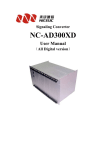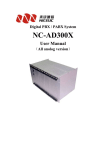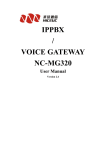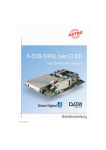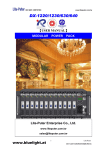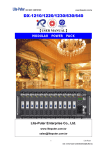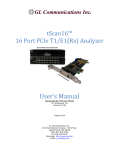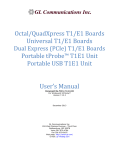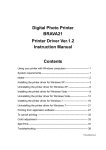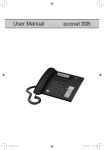Download NC-AD300D Serial Signaling Converter User Manual For PbxD
Transcript
NC-AD300D Serial Signaling Converter User Manual For PbxD NC-AD300D Manual Foreword The purpose of this manual is to supply operating, set up and configure with the information needed to properly and quickly set up and configure the NiceUC's NC-AD300D Signaling converter. We had made every effort to ensure that the information in this manual is accurate and adequate. If you use this manual when you encounter any problems and have any good suggestions , please contact us: ShenZhen NiceUC communication Tech co., Ltd Room 1401, YiZhe Building, YuQuan Rd, NanShan District, ShenZhen City, GuangDong , China Tel:86-755-26722761 Fax:86-755-26526970 Email: [email protected] Website: http://www.nicecomm.com.cn http://www.niceuc.com 2 NC-AD300D Manual Contents Foreword........................................................................................................................... - 2 Contents............................................................................................................................. - 3 Chapter 1 Overview.......................................................................................................- 5 1.1 Brief introduction....................................................................................................... - 5 1.2 Main specialfication....................................................................................................- 5 Chapter 2 Hardware construction................................................................................- 5 2.1 Indicator...................................................................................................................... - 6 2.2 Interface.......................................................................................................................- 7 Chapter 3 Installing Equipment................................................................................... - 8 3.1 Pre-installation preparation.......................................................................................- 8 3.1.1 Device Accessories..............................................................................................- 8 3.1.2 tools..................................................................................................................... - 9 3.1.3 Cable................................................................................................................... - 9 3.1.4 Enviroment....................................................................................................... - 11 3.2 setup step................................................................................................................... - 12 3.3 Notes...........................................................................................................................- 12 Chapter 4 Basic configure........................................................................................... - 13 4.1 Terminal connection................................................................................................. - 13 4.2 Command States....................................................................................................... - 14 4.2.1 Boot states.........................................................................................................- 14 4.2.2 Runing state......................................................................................................- 14 4.2.3 from the boot state to running state............................................................... - 14 4.3 Startup Parameters...................................................................................................- 14 4.3.1 Check boot parameters....................................................................................- 14 4.3.2 modify the boot parameters............................................................................ - 15 4.4 Device IP Address......................................................................................................- 16 4.4.1 View IP address................................................................................................ - 16 4.4.2 modify the IP address...................................................................................... - 18 Chapter 5. Software configuration................................................................................ - 19 5.1 tools............................................................................................................................ - 19 5.1.1 Connect device..................................................................................................- 20 5.1.2 Disconnect.........................................................................................................- 20 5.1.3 Read device parameters.................................................................................. - 20 5.1.4 Write device parameters................................................................................. - 21 5.1.5 Load Parameters..............................................................................................- 21 5.1.6 Export Parameters...........................................................................................- 21 5.1.7 Reset Device......................................................................................................- 21 5.2 Operation configuration...........................................................................................- 22 5.2.1 DSP function.....................................................................................................- 22 5.2.2 Telnet service.................................................................................................... - 22 5.2.3 Login User........................................................................................................ - 22 5.2.4 E1 Configuration..............................................................................................- 23 3 NC-AD300D Manual 5.2.4.1 Clock Source..........................................................................................- 23 5.2.4.2 PCM property....................................................................................... - 23 5.2.4.3 SS7 Signaling......................................................................................... - 27 5.2.4.4 V5.2 signaling........................................................................................ - 28 5.2.5 Call control....................................................................................................... - 30 5.2.5.1 Length Rules..........................................................................................- 30 5.2.5.2 Convert Rule......................................................................................... - 31 5.2.5.3 Routing Rule..........................................................................................- 31 5.2.5.4 Groups....................................................................................................- 36 5.2.5.5 Restrict caller........................................................................................ - 37 5.2.5.6 CDB(Special SID)..................................................................................- 38 5.2.5.7 Virtual caller..........................................................................................- 39 Chapter 6 Calling detail records....................................................................................- 40 6.1 txt format...................................................................................................................- 42 6.2 Database format........................................................................................................- 42 Chapter 7. Debug monitor............................................................................................. - 42 7.1 Initialization Information.........................................................................................- 42 7.2 Equipment Command.............................................................................................. - 44 7.3 calling trace............................................................................................................... - 45 7.4 E1 monitor.................................................................................................................- 45 Appendix 1. The use of Hyper Terminal....................................................................... - 48 Appendix 2. To establish FTP services.......................................................................... - 50 Appendix 3. Recording tone and load to PBX..............................................................- 51 Appendix 4. Equipment software upgrades................................................................. - 52 Appendix5.SS7signaling messages introduction.......................................................... - 53 - 4 NC-AD300D Manual Chapter 1 Overview 1.1 Brief introduction NC-AD300D signaling converter ,use modular structure,real-time embedded operating system,full switching,low power consumption and high reliability. 1.2 Main specialfication Maximum support 16E1 ,16 SS7 links Signaling support Isdn PRI,Q.Sig,Cas,R2,E&M,SS7,V5 SS7 support dual-link load sharing and support group links SS7 support a variety of connectivity ,such as from Network and PCM Support SS7 Signaling gateway(to be on the SS7 connected to the Network from the PCM) Intelligent routing ,according to time slot group,calling party and called party can be used as the routing condion Multi-number transformation ,slot can be grouped ,calling party and called party can be any changed Call restrictions, support for blacklists and whitelists Virtual Calling, Caller ID can be a fixed rule change Support the playback sound, provide simple voice process and support calling party and called party certification Provides detail call record Provides convenient monitor software Provides CTI program interface Chapter 2 Hardware construction Description : 5 NC-AD300D Manual Nice AD-300D with 1U- high chassis, very easy to install in 19-inch cabinet. There are two versions, just behind the interface is different from other functions are the same. V8 version of the E1 interface CC4 coaxial head, V9 and V10 of the E1 interface RJ45 crystal head. internal structure of the diagram is as fllows: Head indicator power bottom Module1 Module2 Back interface bottom up to 8 E1,it can be added two modules,the maxium of a simple module is 4E1. 2.1 Indicator Front panel as shown below: Light fllowed: Run Link Speed D1 D2 D3 D4 D5 D6 D7 D8 D9 D10 D11 D12 D13 D14 D15 D16 Indicator define as fllows: Indicator status change Description Direct Green object on of blink on of blink / Abnormal Fault Normal / / / / / / Run Equipment Normal Abnormal Link Network Normal Fault Speed Net speed 100M 10M D1 PCM0 D2 PCM1 D3 PCM2 D4 PCM3 D5 PCM4 D6 PCM5 Red Data transfer / Warning No link or Link OK link failure / Lose synchronous synchronous from Other side 6 NC-AD300D Manual D7 PCM6 D8 PCM7 D9 PCM8 D10 PCM9 D11 PCM10 D12 PCM11 D13 PCM12 D14 PCM13 D15 PCM14 D16 PCM15 Note:The link indicator is relationship with configuration,it’s take effect when configuration to. Tips:You can dertimine whether the E1 connection ,send and recive is correct according to sync indicator. 2.2 Interface Interface to the back of the device: The back of V8 version as shown: : -48V 220V Power interface switch Power (reserved) interface Reset PCM PCM button recived transfer Console Eth PCM sequencing in the following tables: PCM15 PCM14 PCM13 PCM12 RX16 TX16 RX15 TX15 RX14 TX14 RX13 TX13 PCM7 RX8 TX8 PCM6 RX7 TX7 PCM5 RX6 TX6 PCM11 TX5 PCM9 PCM8 RX12 TX12 RX11 TX11 RX10 TX10 RX9 TX9 PCM4 RX5 PCM10 PCM3 RX4 TX4 PCM2 RX3 TX3 PCM1 RX2 PCM0 TX2 RX1 TX1 The back of V9 or V10 versions as shown: 7 NC-AD300D Manual 220V power inteface switch PCM console Eth interface PCM RJ45 interface switch coax sequence: RJ45 line sequence 1 2 4 5 BNC line sequence out(ring) inner (tip) out(ring) inner(tip) RX TX The two versions of the PCM interface are different from others versions. othes are the same. Power: provides 220V or -48V on-demond, PCM interface:provide the corresponding number on-demond, and it only support E1 currently. Console and ethernet port :to be used as configure and debugging .with RJ45 connector. And ethrnet port is a 10/100 Base-T Ethernet interface,support IEEE802.3 Reset button:can be used to reset device. E1 is the ITU-T developed by the European Association of Postal and Telecommunications (CEPT) digital transmission system named after a group of (ie, PCM30) standard, from 32 64kbps way through the words of the PCM time-multiplexed to form, its transmission rate is 2.048Mbps . Usually 30, then road transport of voice and other user information, the other two telephone channels as the system overhead, transmission synchronization code, signaling yards and other ancillary signals. E1 interface of the physical and electrical characteristics comply with the G.703 standard of CCITT. Chapter 3 Installing Equipment 3.1 Pre-installation preparation 3.1.1 Device Accessories Accessories list accessories number unit Power line 1 article console line 1 article ethernet line 1 article note Crossover cable 8 NC-AD300D Manual E1 line 2 pair Number according to demand Different interface,different E1 line data CD 1 piece 3.1.2 tools Essential: Screwdriver, Crystal head pressure pliers,Wire cutter. Optional:Multimeter,Electric iron,Solder wire,Knife,Needle nose plier,Etc. 3.1.3 Cable Console line: End of RJ45 crystal head,access device.and the other side of RS232 DB Female head,then link to computer. The realationship from console RJ45 to RS232. There are two kinds of network cable ,one is Crossover cable the other is straight-through. If device connect to computer ,please use Crossover cable.If connect to HUB,use StraightThrough cable. Network cable at both end of RJ45 line sequence as shown: cross straight straight cable 9 NC-AD300D Manual E1 line connector CC4 as shown: E1 line interface of RJ45 as shown: E1 line ,usually config RJ45 transfer line BNC,if the opposite end of the side is RJ45.You can DIY it according the fllowing diagram: 10 NC-AD300D Manual 3.1.4 Enviroment a) Power Requirements: Voltage should be constant, the electric current should be sufficient (to meet the nees OK), Power can’t have too much clutter and interference. Power type UPS or Secondary power supply Nominal voltage Voltage input range b) -48V DC 220V AC -48V±15% ensure indicators, -57V~-40V normal work 130v~250v normal Grounding Requirements The engine room must have good grounding,and have separate protected. room of the lighting protection system should be a separate system. its grounding system and used as a reference to the power system and protected room is not shared. c) Temperature and Humidity To ensure the device work normally and to extend the service life ,engine room needs to maintain a certain temperature and humidity, If the room humidity is too high for a long period, it could easily lead to bad insulation or insulation leakage, and also occurs materials, mechanical properties change in such phenomena as corrosion of metal parts; if the relative humidity is too low, causing shrinkage of insulating gasket will screw loose, in the dry weather conditions, but also prone to static electricity, against device electronics; if the temperature is too high will accelerate the aging process of insulating materials, so that the reliability of the device greatly reduced, seriously affecting their life. Temperature Transport and storage -20℃~60℃ Long-term conditions 0℃~40℃ work Humidity Short-term Long-term work Short-term conditions work conditions conditions -5℃~45℃ 5%~85% 5%~90% work The engine room temperature and humidity measurement refers to the equipment rack before and after the failed to protect boards from the floors above 1.5m and 0.4m Description from the equipment rack at the front of the measured values. Short-term work refers to device work conditions, working continuously for less than 24 hours and an annual aggregate of not more than 15 days d) Others The major harzard of device running safty is dust, that indoor dust attched to the body ,leads to electrostatic adsorption, the metal connectors or metal contacts being exposed, not only will affect the service life, but also easily lead to communication failures. When the indoor relative humidity low, the easier to produce this electrostatic adsorption. Therefore, dust needs to be done. 11 NC-AD300D Manual Despite the anti-lightning equipment has done a lot of considerations, but also taken the necessary design and measures, but the lightning intensity over a certain area, it is still possible to cause damage to equipment. In order to achieve a better lightning effectsit is recommended users: . Ensure the equipment chassis of protected areas with the protection of ground to maintain good contact with the earth To enhance the power of the anti-lighting effect,we can consider the input front-end to join in the power supply arrester, so that power can be greatly enhanced the ability of anti-lightning strike. To enhance the power of the anti-lightning effect For the device itself by the user interface to connect to the outdoor outlet signals, such as telephone lines, E1 lines, in order to achieve better anti-lightning effect, users may wish to consider the input of additional signal lines dedicated lightning devices And need to note that electromagnetic interference, with particular attention to anti-static. when the observation or the transfer of the demolition of the circuit board, please contact the circuit board by hand the outer edges to avoid touching the circuit board by hand directly to components. 3.2 setup step At frist please install device and fixed , and then connect the power cord, turn the power switch, observation equipment, lights are normal. To normal, to connect serial cable, network cable, and configure the operating parameters. Configuration is completed, connecting E1 lines. E1 line to connect when you should pay attention to the corresponding synchronous receive light, if the red light, try to connect the TX and RX pairs of words, the red light does not shine can be. 3.3 Notes A. Ground must have good grounding resistance should be less than 5 ohms, preferably less than 0.5 ohms. B. Docking cable, the interface card bits to be solid, appropriate driving force can not fall. C.Pull line, pay attention to circlip, must not use brute force, may cause damage to cable connectors. 12 NC-AD300D Manual Chapter 4 Basic configure NC-AD300D can be configured by two means. 1.Through the console port to connect terminal or PC running terminal emulation software. 2.Through Telnet program on the Ethernet. FTP Server Telnet Ehternet Console NC-AD300D Console terminal But before use the Telnet,we need to know IP address of the device, and ensure the internet smoothly. 4.1 Terminal connection We usually use PC to debugging device,when connecting to device console port,it needs to running a simulation software on PC, In Windows system, the commonly used "Super Terminal." you can also use any other terminal software, recommended the use of SecureCRT. Use of methods about “Super Terminal” can be found in Appendix II or other materials When use console port,terminal parameter configuration as shown: Baud rate 115200 Data bits 8 Parity Stop bits Flow Control None 1 None Notes: Computer usually have two serial ports,COM1 and COM2,if it’s out withUSB-Serial port, then may be COM3,COM4,COM5 etc.please confirm the choice of the port is correct。 It can be use Telnet service through Ethernet connection,in Windows system, point “Start” menu Then choose “Run”,and enter “address of IP” .you can also use other third-party software.such as Secure CRT. Default of the telnet login name is admin ,password is nice. Notes:at the same time ,console port and telnet connection only one,when the telnet Connect ,the Console port will be limited .only when the telnet exit, console port session can be restored . and through the Ethernet you may connect telnet only one,if you have connected a telnet. Re-connect will be limited. 13 NC-AD300D Manual 4.2 Command States There are two status for device, after a normal boot into the running.if the startup was interrupted, it will enter the Boot Status. 4.2.1 Boot states When the device starts, if it has been connected to the terminal, you can see the start of the initialization information. When the Press any key to stop auto-boot ... are prompted to wait for a few seconds delay, then press any key can stop the system start up and goes to boot state, and "[Boot]:" prompt will be shown. In boot state, the equipment is waiting for the basic parameter change such as network parameters, boot methods. 4.2.2 Runing state After start up finished the Equipment will go to running state, the prompt is "->" "In PC terminal,you can view and modify the equipment operating parameters. Running a large number of functions under the command will be described later. Note that all commands are case-sensitive. 4.2.3 from the boot state to running state In boot state, after the prompt of "[Boot]:" enter "x", the equipment will be loaded from the Flash started into running state. If the FTP server has been configured, you can also type "@", the equipment will be start to load the file from FTP server. 4.3 Startup Parameters 4.3.1 Check boot parameters If in the boot state, "[Boot]:" enter "p" 14 NC-AD300D Manual If in running state, "->" , enter" pboot " boot parameter as follows: boot device :at the system boot device name unit number :0 Number of startup equipment unit processor number:0 number of processors host name:server host name file name:pbxd. netloaded at startup from the network file names inet on ethernet(e):192.168.16.254:FFFFFF00 device itself ipaddress:Subnet Mask host inet (h):192.168.16.85 FTP host IP address of service gateway inet (g):192.168.16.1 Ethernet Gateway IP adress user (u) :pbx connect FTP service user name ftp password (pw):nice connect FTP service password flags (f):0x0 boot parameters DeviceID :0x0 device ID 4.3.2 modify the boot parameters If in boot state, "[Boot]:" type "c" If in running state, "->" type “cboot” Instructions: Type the new value directly behind the old value, enter the changes, and then move to the next one. Enter ".", Then delete the current content. Enter "-" then return to the previous row to make changes. Enter "Ctrl + D", exit change. Directly press enter, will move to the next one. boot device: at0 can not be changed processor number: 0 can not be modified host name: server can be freely modified file name: pbxd.net according to the actual file name changes inet on ethernet (e): 192.168.16.254: FFFFFF00 Modification form must be filled, if not the subnet mask, default taken 255.255.255.0 host inet (h): 192.168.16.85 Upgrade by FTP software to use, usually do not need to modify gateway inet (g): 192.168.16.1 Intenet using to access the gateway address, depending on the network situation. user (u): pbx according to practical situation ftp password (pw): nice according to practical situation flags (f): 0x0 15 NC-AD300D Manual Parameter values can be bitwise combination. 0x04 – go to the boot startup state, rather than running state. 0x08 - Quick Start to run state can not enter to boot state. 0x20 - Disable Telnet login account authentication. 0x40 - use DHCP to automatically obtain parameters. 0x80 - load the boot image from tftp. 0x100 - use proxy arp service. 0x200 -0x400 – load from ftp to boot 0x800 - manually set the MAC address. 0x1000 - start the DHCP service. 0x2000 - use watchdog. target name (tn): e3 can be freely modified startup script (s): must be empty other (o): must be empty DeviceID: 0x0 can be freely modified Note that the modification will be effect after re-start up. 4.4 Device IP Address 4.4.1 View IP address A) ipconfig Use the ipconfig command to query the device IP address for the primary user. Examples are as follows -> Ipconfig ip = 192.168.16.100: ffff0000 the device IP address "192.168.16.100", the subnet mask for the hexadecimal form converted to decimal as "255.255.0.0". B) ifconfig Use ifconfig command to query the device IP address for the primary user. Examples are as follows -> Ifconfig ip = 192.168.16.100: ffff0000 the device IP address "192.168.16.100", the subnet mask for the hexadecimal form converted to decimal as "255.255.0.0". C) ifShow Use ifShow command to view the device details of network parameters for advanced users. Examples are as follows -> IfShow at (unit number 0): Flags: (0x8063) UP BROADCAST MULTICAST ARP RUNNING 16 NC-AD300D Manual Type: ETHERNET_CSMACD Internet address: 192.168.6.100 Broadcast address: 192.168.255.255 Netmask 0xffff0000 Subnetmask 0xffff0000 Internet address: 200.0.6.99 Broadcast address: 200.0.6.255 Netmask 0xffffff00 Subnetmask 0xffffff00 Ethernet address is 08:00:3 e: a8: 06:64 Metric is 0 Maximum Transfer Unit size is 1500 323677 octets received 213766 octets sent 4596 packets received 4066 packets sent 2387 non-unicast packets received 7 non-unicast packets sent 2209 unicast packets received 4059 unicast packets sent 0 input discards 0 input unknown protocols 0 input errors 0 output errors 0 collisions; 0 dropped lo (unit number 0): Flags: (0x8069) UP LOOPBACK MULTICAST ARP RUNNING Type: SOFTWARE_LOOPBACK Internet address: 127.0.0.1 Netmask 0xff000000 Subnetmask 0xff000000 Metric is 0 Maximum Transfer Unit size is 32768 0 0 0 0 0 packets received; 0 packets sent multicast packets received multicast packets sent input errors; 0 output errors collisions; 0 dropped D) pboot Use pboot command to view the basic parameters of the device. Examples are as follows -> Pboot boot device: at unit number: 0 processor number: 0 host name: server file name: pbxd.net 17 NC-AD300D Manual inet on ethernet (e): 192.168.16.254:FFFF0000 host inet (h): 192.168.16.5 user (u): pbx ftp password (pw): nice flags (f): 0x0 target name (tn): d DeviceID: 0x0 The above example, "inet on ethernet (e):" is the device behind the IP address, and the ifconfig command to see to the format, the device IP address "192.168.16.254the subnet mask for the hexadecimal form of conversion into a decimal to "255.255.0.0". 4.4.2 modify the IP address A) cboot Use cboot command to modify the device's IP address, operating process is as follows: -> Cboot '.' = Clear field; '-' = go to previous field; ^ D = quit boot device: at0 Enter processor number: 0 Enter host name: server enter file name: pbxd.net Enter inet on ethernet (e): 192.168.16.254: FFFF0000 Enter the new IP address + Enter inet on backplane (b): Enter host inet (h): 192.168.16.50 Enter gateway inet (g): 192.168.16.1 Enter user (u): pbxe Enter ftp password (pw) (blank = use rsh): nice Enter flags (f): 0x20 Enter target name (tn): d Enter startup script (s): Enter other (o): Enter DeviceID: 0x0 Enter Instructions: In the current row directly type the new value, press enter to change, and then move to the next parameter. Enter ".", Then delete the current content. Enter "-" and return to the previous row to make changes. Enter "Ctrl + D", exit changes. directly press enter, then move to the next one. IP address format is still IP: subnet mask, for example the IP address need to be changed to 10.1.123.145, subnet mask as 255.255.254.0, then need to type the value as: 10.1.123.145: FFFFFE00 18 NC-AD300D Manual Note that the modification will be effect after re-start up. B) ifconfig Use ifconfig to set IP address can be effective immidiately. Examples are as follows -> Ifconfig "192.168.16.105: FFFF0000" ip set 192.168.16.105: ffff0000 ok The example set IP address "192.168.16.105", the subnet mask for the hexadecimal form converted to decimal as "255.255.0.0". ok means modification has been finished Note: This method modify the IP to take effect immediately, but don’t save, even after reboot take boot parameter. Chapter 5. Software configuration 5.1 tools Run the tools of PbxConfig.exe,the tools looked as below: 1.Operation 2.Index 3.Parameter 4.result message Interface divided into four areas, 1. Equipment operation, including menus and toolbars. 2. Parameter index is the device operating parameters of a classified index. 3. Parameters value displays the current parameters of the index of specific parameters. 19 NC-AD300D Manual 4. Message showing relevant operational status and results 5.1.1 Connect device First, fill in the correct device IP address, and then click Button or in the "Device" menu, select "Connect." If the connection is successful, IP address bar will turn into gray, such as , At the same time, the status bar will show "Connect". 5.1.2 Disconnect Click Button or in the "Device" menu, select "Disconnect." If successful disconnect, IP , At the same time, the status address bar will restore inputable, such as displays "Not Connected." 5.1.3 Read device parameters After a successful connection, point Button or in the "Device" menu, select "read." Will be prompted to enter a user name and password The default user name admin, password is nice If the parameter was successfully read, read out all parameters will be prompted to complete. For this operation, you need to pay attention "to read and write target" option. ROM is like 20 NC-AD300D Manual a computer's hard drive, RAM is the computer flash memory, can only choose one of them. 5.1.4 Write device parameters After a successful connection, point Button or in the "Device" menu, select "Write." If you write to the success of all the parameters will be prompted to write to finish. Write operations, you need to pay attention "to read and write target" option. Write ROM data is not lost after power-down, write RAM data will be lost after power-down, but some parameters can take effect immediately (without restarting equipment with immediate effect). also proposes to select the ROM and RAM in the same time for write operation.。 5.1.5 Load Parameters Device parameters can be saved as a text file form. The text file can be loaded into the device, commonly used to restore the backup configuration. Point Button or in the "File" menu, select "Import." Note that the import operation is just the parameters loaded into the buffer configuration tool,and not written to the device. 5.1.6 Export Parameters Device parameters can be saved as a text file. This is mainly for the back up the configuration of the devices. Click Button or in the "File" menu, select "Export." Note, remember to read the the device configuration before do the export action. 5.1.7 Reset Device 21 NC-AD300D Manual Click Button or in the "Device" menu, select "Reset", the equipment can be reset. When modify parameters, it is recommended to read out the parameters of the device and import to back up first, and try to back up for each modification to avoid mistake and can not be recovered. 5.2 Operation configuration 5.2.1 DSP function DSP function is the essential function of the device must be properly set up, In the left side of configuration tool click"system parameters" index, and modify the parameters in the right side. AD300D have four DSP, usually according above of the configuration Note: Using CAS,you should config “MFC/DTMF” and “DTMF(06)” After completion of editing, write to ROM and restart the device to take effect. 5.2.2 Telnet service In the left side of configuration tool, pleas click"system parameters" index, and modify the parameters in the right side Here can modify telnet listenport After completion of editing, write to ROM and restart the device to take effect. 5.2.3 Login User Specify the telnet connection and configuration tool for certified users, up to 10 users set up. 22 NC-AD300D Manual Choose “Loginuser” in parameter index area,and you can find there is loginuser list in the right side. Using “data” menu,toolbar or right menu to do add and delete operation. After completion of editing, write to ROM and RAM . restart the device to take effect. 5.2.4 E1 Configuration If you need to use E1 lines, then the configuration of E1 is necessary. E1 transmission is synchronized signals, using the call signaling control. 5.2.4.1 Clock Source E1 clock synchronization signal needs to be unity for working properly. AD300D itself does not provide the clock source, but it can get the clock from other side through E1.you can click “system parameters ” index ,and modify E1 clock source on the right parameter area. Tips: Usually get the clock source through PCM0 23 NC-AD300D Manual After completion of editing, write to ROM and restart the device to take effect. 5.2.4.2 PCM property Set the relevant properties of PCM. In the INDEX area select the "PCM", Pamameter area shows as below: PcmID, PCM's number, see the hardware description. Line impedance, E1 lines using coaxial cable connection typically use two kinds of 120-ohm or 75 ohm impedance.(if device interface is CC4 small head ,you can only us 75 ohm ) CRC4 check, physical frame of the 4-byte cyclic redundancy check. Normally enable. Signaling type, set the signaling type of PCM. AD300D supports the following signaling. A) ISDN PRI, or Primary Rate ISDN (Primary Rate Access), also known as Digital One (DSS1) signaling, the domestic usually 30 B channels plus one D channel (30B + D) approach. B) SS7 signaling, SS7 signaling is a common international standard for common channel (Common Channel) signaling system, which uses a layered functional structure and message communication mechanism, the most suited for the use of modern digital communication network. Currently AD300D support TUP (Telephone User Part) and ISUP (ISDN User Part). C) V5.2, to connect AN (Access Network) access network and the LE (Local Exchange) the local exchange network V-interface. Signaling parameters:signaling related to the detailed parameters. ISDN PRI signaling has the following parameters: 24 NC-AD300D Manual Network mode: two options, the network side or user side. can not be the same at both ends. Calling attributes, caller screening, caller display, called attributes, set the number of properties, usually select the default value. MfcVallDelay: When receiver number, if the number is passed by bit, will wait this value of ms(second) for next bit. If longer than this time but did not receive next bit, then the number receiving has been completed. Usage pattern: usually choose "normal mode." "Signaling Collection" and "high-impedance recording" in and line monitoring of the use of high barrier from the need for external devices can be collected signaling, monitoring recording. When the check the "ring-back does not pass through", the device will provide their own ring back tone, rather than pass through the next level. On the SS7 signaling parameters are as follows: Link ID, the Link ID in this PCM , see description of SS7 link in later chapter, SS7 link should be added before configuration the SS7 parameters. CIC, the time slot number in each E1, This CIC number is the number of E1, number oftime slot in this E1 will be automaticly increased. For example, CIC set to 0, then time slot 0-31 in this E1 will 25 NC-AD300D Manual be from 0 to 31; if the CIC set to 1, then the time slot 0-31 in this E1will be numbered from 32 to63 If the CIC set 2, then the time slot 0-31 in this E1 will be numbered from 64-95; and so on. MaskTimeSlot: will mask this timeslot to be non-exist. On the CSS1 sigaling parameters are as shows: Device support MFC and DTMF two kinds of hair yards way. PCM multiplexing for digital-analog conversion, the time slot channel line-one correspondence with the module, which is equivalent analog line extension through E1. The default settings are usually able to successfully connect, if client requests are special, according to manually specify the DL value. V5.2 signaling parameters are as follows: 26 NC-AD300D Manual CIC: identity V5 within the PCM-link a logical sequence of numbers, both sides must be consistent. Attr: to specify the primary link, 2nd link or no link. Link time slot: designated which time slot is C-channel. When you select no link, unused slots can be blocked. After completion of editing, write to ROM, restart the device for effective. 5.2.4.3 SS7 Signaling For use of signaling SS7, you must first add the link parameter. In Index area select SS7 signaling, right click mouse button to add a new SS7 link in Parameter area. This Can also be done in the "Data" menu, select "Add", or click add a link. Once installed, then modify the parameters one by one. on the toolbar Button to 27 NC-AD300D Manual Link ID, Internal index number for SS7. Link Code (SLC), the logical link number, must be consistent with the SS7 equipment on other side. Click to Edit. Business types, currently supports two kinds of TUP and ISUP. Click to select. Connection method, specify the link where to connect. Click to select. No, that there is no link connection, this link is invalid. Hand Link, the link is from E1. Netclient, get ss7 link from SWGIP NetServer, forward SS7 link data through Ethernet (service side). NetworkServerAndClient, including "NetClient" and "netserver" for cascading multiple devices SGW, connection from the PCM link, and transfer it to network for secondary development. Link time slot, which time slots have the SS7 link. Signaling point code-bit length, specify the length of the signaling point codes. Usually 24-bit for domestic and international use 14-bit. Signaling point code, SS7 signaling code, in the format XXX-XXX-XXX. Backup link slot, If use 2 SS7 link to back each other, time slot for the back SS7 link.(load sharing). Caller category, caller attributes, caller screening, caller display, called attributes, specify the number of attributes called the primary, usually select the default value. MfcValdelay, if calling number is received by-bit, over this time the receiving will be finished. Usage pattern: usually choose "normal mode." "Signaling Collection" and "high-impedance 28 NC-AD300D Manual recording" in and line monitoring of the use of high barrier from the need for external devices can be collected signaling, monitoring recording. When the check the "ring-back does not pass through", the device will provide their own ring back tone, rather than pass through the next level. After completion of editing, write to ROM, restart the device for effective. 5.2.4.4 V5.2 signaling When using V5.2 signaling, the need to set the link parameters of V5. AD300D maximum support One dirction , two links. Goes to "V5.2 signaling" and see belowparameters. V5 variable and V5ID are the main parameters that must be consistent with the other side. Interface type, designated as the AN side AD300D or LE side. Access network AN is an abbreviation from the Service Node Interface (SNI) and the associated user-network interface (UNI) between the number of transmission entities (such as the line facilities and transmission facilities), is for the supply of telecommunications services to provide the necessary carrying capacity the implementation of the system. An AN can be reused, exchange connectivity and transport functional components. LE is a local switch acronym, it’s a subscriber line through the AN terminating switches. After completion of editing, write to ROM, restart the device for effective. L3 address, is EFaddr types of PSTN signaling or control protocol message in the third layer of the address. The aim is for the user port or public control functions provide a unique reference. Goes to "L3 address" see below L3 address table. 29 NC-AD300D Manual One Phone number is corresponding to one address. In the "Phone Number" column on the right-click pop-up menu can be "incremental", "decreasing" or "Batch Edit" number of the table. After completion of editing, writing to ROM and RAM, can be effective immediately. 5.2.5 Call control First need to group the same type of interface, as shown below: Right click in the table, pop-up action menu, can add and delete. User Can also goes to "Data" menu operation. Or use the toolbar Button operation. Once added, first select the "Line Type", then select line range (Note that the end value of LineRange is excluded), at last select the rules for these LineType. Rules including Length rules, number conversion rules and routing rules. Number conversion rule can be applied to call in and call out. Each rule table can define multiple groups, each group there are multiple rules. Note that the call in and call out is base on the AD300D itself 5.2.5.1 Length Rules When the AD300D is receving the caller ID, we need to determine the length of each number. In Index aera , select "SysPart->Rule->Length" will see the length table in the right, Use "Data" menu or 30 NC-AD300D Manual toolbar, or right-click menu, to add the length table. The highest of number, matching conditions,“x”means NULL,none of the number can be matched, “?” is wildcard, it means any number. Length rule to serach the caller ID by devided it into sereral parts, maixma 8 parts. Fisrt to match it with the smallest grade, if the "FindingResult" is "Finded, End", then the search stop, otherwise, to subtract ThisLength for alreading found, and continue searching for next part. If you can not find match for the next part, then number will be the "default length of the follow-up," or serch failed if this value not be set. See figure above configuration, for example, in RuleID 0, when called number is 17909075526520000 then search process is as follows: First, check rules in grade 0, SID = ? (SID =surfix of caller ID), ? = all numbers), "The length" is 0, and FindResult is Continued to Find, Next Length = 8, then keep searching in grade 1, in grade 1 there is a rule SID = 17909, match with this caller ID, "ThisLength" = 5, and FindingResult is “Continue to Find, Length unknown”, so thisLength will be cut, the number will change to 075526520000, and we keep searchingi n Grade 2, SID = 0755 to match with the number. 5.2.5.2 Convert Rule Choose “number transform” in the parameters index area,you can find “number transform” list on the right side.use “data” menu,toolbar or click right menu to add and delete the table. There are two determine the conditions,one is “Goup ID”,the other is “CDB”. “CDB” is the beging part of the number,”?”is Wildcard.it means any number,”X” means NULL,when the Group number is grater than 128,it said that to determine caller ID. if the Group number is shorter than 128.it said that to dertimine called number. Tips : When there are some “$”characters in prefix and suffiex. It means that inter original call and need signaling support. 31 NC-AD300D Manual 5.2.5.3 Routing Rule In Index area, select "SysPart->Rules->router" to see the router table, Use "Data" menu or toolbar, or right-click menu, to add and delete the table. The following for a detailed description of each parameter: RuleID, specify which group belongs to the routing rules. Priority, specify the priority of routing rules, will be related to the priority of analog circuit parameters in the SLC->Line Part table. SID, the Prefix of the calling number. The conditions to make judgement. Sequence, the action will be followed from the sequence small to large, so when the small sequence failed, route can goes to larger number sequence, thus can back up for multi routes. Action, specify how to handle the call. There are several options below: 1. Switch to digital trunk To forward calls to E1 trunking. The PCM time slot will be used for the call is decided by the selection in description. There are three options to choose from. 32 NC-AD300D Manual 1)Specify PCM, as shown below: PCM ID is the E1 that you want to select. 2) specify Line Range, as shown below: Select PCM time slot from start to the end, note that for PCM0, the number of time slot is from 0 to 31, for PCM1 is from 32 to 63, and so on. 3, specify the PCM group, as shown below: 33 NC-AD300D Manual In the PCM group you can select round in group or sequence in the group, RoundInGroup, each time when call in will select the timeslot one by one from beginning to the end. SequenceInGroup, always selct the timeslot from the beginning for each time call in. only busy to select the next one. Members of group will be configured in the “Route->Group-> PCM”. In the Attr column will configure the caller ID forward mode, bit-forward or one timeforward. When using FXS to call out, you can specify the outbound Caller ID use"extension number" or "Direct numbers." 1) Auto attendant AD300D provides a simple Auto attendant process. Including six response voice as below NO. Tip of the contents Example 1 Welcome Tips “Welcome to XXX company 2 Operation Tips “Please dial extension Number,dial zero for help” 3 Busy Tips “user is busy now 4 No answer Tips “Nobody answer the call now 5 No number Tips “The number you call doesn’t exist” 6 Dial extension failed “Please call later or change Tips other numbers” When a call comes in, the Auto attendant play the first voice, then plays the second, waiting for the user to press key, and then according to the key to play different voice. In column of description, click to pop-up dialog box for key operational definition. 34 NC-AD300D Manual "WaitDelay" is used to set the timeout to receive the button, if more than this time no button pressed, will stop waitting. "WaitLength", if set to "unknown", according to the definition in "Process using” to deal with; otherwise, according to the selection length to do treatment; proposals set to "unknown". "End Key" to specify which key to press is the end of numbers, usually set to "#." "LoopTimes" designated number of times the playback voice prompts. If more than this number, still no button pressed, then the call will be terminated. “PromptVocIndex” designate the welcome prompt tune, main instruction tune and fail prompt tune voice index.if you fill out”0”.use the default voice. “Process using” designates the follow up call process after the selection key pressed Tips:More than one route can be configured out of a simple nested multi-level menus Process。 1) Secondary Dial-up play dial tone to prompt the user to re-dial.It is the same to the “turn computer operator” function, the only problem is that it playdial tone only one time,while “turn computer operator” can play back recorded voice. Routing content to set operational definitions, as follows: 35 NC-AD300D Manual the parameter is the same with the "turn the computer operator" parameter.no more detaile description 2) CTI Control Calls can be transferred to the CTI program to control,CTI group parameters as a logo Parameter. It will be sent to the CTI program interface 3) SWitch to digital Trunk( Trunk(Transmitted by the virtual caller) caller) The basic function is the same to “switch to digital trunk”, But it will follow the virtual caller ID to select the channel line. 5.2.5.4 Groups 36 NC-AD300D Manual Goes to “SysPart->Rule->Router->group”, you can set up groups for PCM PCM group, set the PCM of the grouping. Instructions: Group number is fixed, only need to add the lines or timeslot in that group. 5.2.5.5 Restrict caller Device can restrict route through with the number of in-bound, in the fllowing of the “syspart—>Rule—>routerrule—>restrict ” .there are two table :whitlist and blacklist,the number of the blacklist are not allowed ,and the oppiste is to the whitelist. Device maxium support 320 black and 320 white list. Click right menu to operation,as fllowing: 37 NC-AD300D Manual Each number can be grouped up to 10 groups,after add numbers,you can use the routing specified on the group number As fllowing: After completion of editing, write to ROM, restart the device for effective. 5.2.5.6 CDB(Special SID) When you need to select a large number of SID, that you can use CDB. On the left side of configuration tool and Click “system parameter —>Rule — >CDB” index , and you can increase number on the right side of “CDB” table. 38 NC-AD300D Manual Every number correspondence a group number,and you can not only increase single,but also batch. Click right menu operation,to support load numbers from the files. After add CDB numbers, you can reference them in the routing and convert rule tables. As frist , you must add a virtual rule that SID format is “cdb,xx” ,xx means character length, If you want to match that figure above 8-bit word length of crown number,and then add the actual number. When device are searching crown number, if there have vitural rules, then it will After completion of editing, write to ROM and RAM for effective. 5.2.5.7 Virtual caller Device provide a group virtual caller number, it can be used for in-bound or out-bound, at frist.you can set some number at the “virtual caller” table,as fllows: 39 NC-AD300D Manual it can support 2560 virtual caller number total,and the method of use can be set in “PCM” click “Linepart—>PCM”,and open “PCM table”, you can choose “Application” list,then it shows application set dialog, as fllows: You can use virtual caller not only in-bound but also out-bound,only to check the corresponding, There are four kinds of use methods: FixTimeSlot: According Slot-Channel to corresponding the caller one by one. Sequence: select number of turns in order in the whole virtual caller table Random,select number by random method in the whole virtual caller table TimeSlot Sequence,select number of turns in order in the whole virtual caller table ,and you must corresponding Slot number. 40 NC-AD300D Manual Notes: After completion of editing, writing to ROM and RAM, can be effective immediately Chapter 6 Calling detail records AD300D send out the CDR through net port. For receiving CDR, other software need to run. For set up the destination of the CDR goes to “SysPart” The original format of CDR is text strings, each one with "R" at the beginning and "\ r \ n" at the end. With a space between each text string separated by fixed length, if the text string is not long enough, will add the space to this fixed length, in the text string, there are four kinds of line types, 0 is E1,1 is analog line, 2 is VoIP lines, 3 is wireless lines. Call duration is seconds. There are three formate of CDR, 1, 2 and 101 which are shown below: Format 1 Inbound Outbound String logo line Called Talk number time End caller line type type Length 1 1 1 Description R space 1 1 space 1 15 1 20 1 5 2 spae Left Space Left Space right “\r\n” String Example: “R 0 1 88889010 98888 5” The sample indicated that calls from analog lines to digital trunking, calling number is 88889010, the called number is 98888, call duration is 5 seconds. Format 2 String logo Out In bound bound Line Called Talk number time caller End Line 41 NC-AD300D Manual type Length 1 1 Description C Space type 4 1 4 space String Example :“C 0 1 15 1 20 space left space 1 1 18 88889010 left 1 5 空 格 2 right “\r\n” 98888 5” Outbound lines and incoming line length is 4, the first one is line type, the latter three is the line number. The sample indicated that calls from analog lines number 18 to digital E1 timeslot 1, calling number is 8888 9010, the called number is 98888, and call duration is 5 seconds. Format 101 String Length Out bound In bound Out bound Called Talk line type line type line NO. number time logo 1 End 1 Description R space 1 1 1 space String Example :“R 0 1 001 1 15 space Left 1 20 1 5 2 Space Left Space right “\r\n” 98888 5” The sample indicated that calls from analog lines to E1, the called number is 98888, call duration is 5 seconds. Voice over UDP format is only an effective way. If voice over TCP ,The format as fllows: "\rCaaaa1,aaaa2,sssss,nnnnn,bbbb,cccc\n" Beginning at”\r”. as the identity Character “C” aaaa means : line number ssss means :end_calling time nnnn means: talk_duration bbbb means:caller cccc means:called number the end : a carriage return “\n” when we using “wcdrrx”,the format of CDR as fllows: 6.1 txt format 42 NC-AD300D Manual CDR field as fllows: Caller,called number,starttime,endtime,talk_duration,in_channel,out_channel. The format of time : year-month-day,hour:miniute:second.the format of channel:PCMID.slot 6.2 Database format Table name:cdr Field Definitions: Id type:int(10) unsigned,Not null, automatically increase,the primary Key deviceid` type:smallint,Not null, default:0 in_channel`type:int(11) ,Not null,default : 0 out_channel`type:int(11) ,Not null, default :0 incomingtime`type:datetime,Not null ,default :'0000-00-00 00:00:00' duration`type:int(10) unsigned,Not null ,default:0 caller`type:varchar(30),Not null,default:'' called`type:varchar(30),Not null,default:'' fail`type:tinyint(4),Not null,default :0 field means as follows: ID,deviceID,in_channel,out_channel,incomingtime,talk_duration,caller,called,fail cdr.sql Chapter 7. Debug monitor 7.1 Initialization Information During device start-up there will be some initialization information, the information can be judged according to the device working condition. The following information is some commonly used example for reference purposes only. Now link status is speed: 100, duplex: FullDuplex This line is the net port initialization information, device start-up will automatically detect the speed of Ethernet, speed: 100 Mbps network, FullDuplex . If it is speed: 10, the network is 10 Mbps, If network is not connected, you can not do automatically detection. The default speed is set to 100 Mbps Network. dsp[0] dtmf06 load ok! 43 NC-AD300D Manual dsp[1] metrec load ok!] This is a DSP chip initialization information, the format is "dsp [number] function description, loaded situation." Number start from 0. Function including voice, dtmf mfc, metrec, conference, callerid and so on. If load successful then "load ok", or else (like add [80]: 0x0! = 0xf073) means load failed. voc channels: 64 The number of voice processing resources available, one DSP has 64 channels. voc read num: 6 number of automtic Voice response resources have been loaded, -1 indicated that there is no voice. voc num: 6 voc [0] len: 17760 ......... After the success of voice-loaded, display the total number and size of each audio file, in bytes. The following is a list PCM signaling pcm [0] ss7 link [0], ts = 16 pcm [1] ss7 link [1], ts = 16 ss7 [0] mailnum: 1 ch (1,32) start ... ss7 [1] mailnum: 1 ch (33,64) start ... Here is information on STUN set stun server = [: 3478] The following is CtiLnk development interface server startup information CtiLnk enter ... CtiLnk tcp server enter ... lnk: 0 recv err CtiLnk listen ... lnk: 1 recv err Here are the voice recording and playing server from network startup information VocCmd enter ... NetVocRx run ... VocCmd tcp server enter ... VocCmd listen .. Here is information on the network configuration server startup NetCfg tcp server enter ... NetCfg listen ... NetCfg accept ... McuTimer task spawn Here is information on PCM synchronization pcm: 0 sync: 0x3 pcm: 1 sync: 0x3 If the PCM synchronization loss will appear pcm: X sync: 0x3 or pcm: X sync: 0x1, success will occur if the synchronization pcm: X sync: 0x0. Where X is the PCM number. If there pcm: X sync: 0x2, showing the alarming from opposite side. 7.2 Equipment Command Common Command Description 44 NC-AD300D Manual Order Parameters Description View basic information ver Query the device software version devinfo Read device information pboot See basic setting shsid Read Equipment Serial Number sgmtime Show Time ipconfig Read IP address ifconfig The new IP address Read and modify new address Modify sample“ifconfig “192.168.16.253:FFFFFF00”” View resources LineGrpShow View call control table CvTableShow View number convertion table LenTableShow View number length rule table RtTableShow View the routing rules table PcmAppShow PCM code View PCM parameters Ss7AppShow Link ID View SS7 link parameters VocSrcShow View voice resources Operations command cboot ldvoclib ldboot ldapp chkapp Modify basic setting FTP connection mode (0=active mode,1=passive mode) FTP connection mode (0=active mode,1=passive mode) FTP connection (0=active mode,1=passive mode) FTPconnection mode (0=active mode,1=passive mode) Add speech database Update device Boot Update device software Calibration device software settime Hours,minutes,seconds setdate Year,month,day,hour,minute, Set date and time second reset Set time Reset device ChannelAlerting Line type,line number ,model Line reminder ChannelAnswer Line type,line number ,model Line answer ChannelReleaseBy ChannelAttrPrn logNetEn Line type,line number,called status Line type,line number Release line View detail property of lines Enable the Ethernet port to send messages 45 NC-AD300D Manual logNetDis Close net mouth send a message logTerEn Enable the serial port send a message logTerDis Close the serial port send a message Debug monpcm PCMID, switch (0 or 1) monpcms PCMID, number switch (0 or 1) PCM volume control monss7 LinkID, switch (0 or 1) Monitoring on the SS7 monss7s LinkID, the number of Volume control on the 7 th signaling Monitor PCM switches (0 or 1) setlapp Trace levels (0 ~ 7) Global call tracking setlhdlc Trace levels (0 ~ 7) Tracking HDLC imformation setlpri Trace levels (0 ~ 7) Tracking PRI signaling setlss7 Trace levels (0 ~ 7) Tracking on the 7 th signaling setlmtp2 Trace levels (0 ~ 7) Signaling MTP2 part of the track on the 7th setlusr Trace levels (0 ~ 7) Track analog line setltab Trace levels (0 ~ 7) Tracking call control look-up table setlex Trace levels (0 ~ 7) Tracking the exchange of operation setlvoc Trace levels (0 ~ 7) Tracking voice operation setlcdr Trace levels (0 ~ 7) Track,then send the case ErrorCode Mistake code See the error code information ErrorHelp Show trace levels of the detailed description of Note that all of the commands are case-sensitive. 7.3 calling trace Using setlapp 7 command can track calling record . 7.4 E1 monitor The small tools of NiceMonitor.exe is to monitor the E1 status of AD300D. Monitor use UDP network connections. In the configuration tool interface, the parameters of the index area, select "SysPart" in the right to see the UDP port. 7400 is commonly used. 46 NC-AD300D Manual Monitoring software interface is as follows: NiceMonitor can monitor all of the equipment from Nice Communication which has E1 interfaces. multiple devices can be monitored, the port for each device must be set to different values. Add your equipment, by click the shortcut of , input the parameter of this device: After finished, double-click to open control device. As shown 47 NC-AD300D Manual Each E1 expressed by two square boxes, the red color means failure, the green color means normal. The left boxes indicate the physical synchronization signal. The right box indicate the HDLC link status. "Ss7Link" Here is the status of signaling links on SS7 signaling. Double-click the sync box (left), you can open the current E1 channel state table. Double-click the link box (right), you can open the link data tracking. 48 NC-AD300D Manual Appendix 1. The use of Hyper Terminal Create a hyperterminal, click "Start -" program - "Accessories -" Communication - "Hyper Terminal" menu, pop-up "New Connection" wizard, fill in names as "HTCOM1-115200", then select one your favorite icon. Click "OK", a dialog box appears as follows: Select the connected serial port, click "OK", pop-up properties interface of the Settings dialog box. 49 NC-AD300D Manual Click "Restore Defaults", change the "bits per second" to 115200, then click "OK" appears below thewindow. This has been established, you can save it to your desktop for easy use next time. Click "File -" Save As "menu can be saved to your desktop. 50 NC-AD300D Manual Appendix 2. To establish FTP services FTP is a file transfer protocol, when the device to download a file from your computer to use. If the computer does not have FTP service program, you can use CD-ROM included with Wftpd32 software. It is a small and easy to use FTP server program. After the interface is running as follows: Next, create a new user: Click "Security" menu, select "User / right ...", the following dialog box appears: Click "New User ..." button, enter the user name, such as pbx, click "OK" To enter a password, such as nice, click "OK", In the Home (FTP services in the root directory), followed by the edit box enter a path, such as "D: \Pbx", you can point "Browse ..." Browse to select the path. 51 NC-AD300D Manual Finally, click "Done" button to complete. If you need to display the log, in the "Logging" menu, select "Log options", the pop-up "Logging options" Settings dialog box. Check the appropriate option, click "OK". Appendix 3. Recording tone and load to PBX You can use the recording software (such as Windows system with a tape recorder) to record tone. Saved as a wav sound files, format must be used CCITT A-Law, 8kHz, 8 bit, mono, 7kb / sec. After recording finished, use NiceVocMake.exe for formate transfer. Run NiceVocMake.exe, interface is as follows. 52 NC-AD300D Manual Click " " button, will add the recorded wav file, select the added item, click can play the tone,and click can re-select the file, and , positon of this tone up or down, Then click button can move the , to save these tone file into the BIN file. After the Bin file was made (usually 300evoc.bin), put it into the root directory of FTP accounts In Running state of telnet, type the command: dwvoclib Message show as follows: Upload file of AD300D to FLASH! Data in FLASH will be erased, continue? (Y/N) Enter Y to continue, type N is cancel. HOST: server --->here to enter the FTP host IPIP address. The default is server, which is the IP address in startup parameters. USER:pbx --->here to enter the FTP account name.default : pbx。 pbx。 PASSWORD: nice--->here here to enter the FTP password,default :nice。 nice。 FILENAME: voclib.bin--->where the name of bin file to be load .。default :voclib.bin :voclib.bin。 .bin。 Loading...... Received bytes: number of bytes shown here updated. ...... After loading is complete, restart the equipment to be effect. 53 NC-AD300D Manual Appendix 4. Equipment software upgrades Note: Be careful about software upgrade ,improper operation will cause the device not work. Start the FTP service, put the file will be upgraded (usually pbxd.bin) into the FTP root directory. in running state, input the command ldapp to upgrade. Message show as follows:Upload file of AD300D to FLASH! Data in FLASH will be erased, continue? (Y/N) Enter Y to continue, type N is cancel. HOST: server ---> here to enter the FTP host IP address. The default is server IP address in startup parameters. USER:pbx ---> here to enter the FTP account name. The default is pbx. PASSWORD: nice--->Here Here to enter the FTP password ,default :nice FILENAME: pbxd.bin---> Enter to load the upgrade file name. The default is pbxd.bin。 pbxd.bin。 Loading...... Received bytes: number of bytes shown here updated. ...... After loading is complete successfully , restart the equipment to be effect. In boot state, use command "u" to do upgrade. In the [Boot]: prompt, enter "u", message show as follows: boot device : at unit number : 0 processor number : 0 host name : server file name : pbxd.net inet on ethernet (e) : 192.168.16.155:ffff0000 host inet (h) : 192.168.16.5 user (u) : pbx ftp password (pw) : nice flags (f) : 0x20 Attached TCP/IP interface to at0. No link,set speed:100,duplex:FullDuplex No link,set speed:100,duplex:FullDuplex Attaching network interface lo0... done. Begin to Load pbxd.bin And then use the "x" command to start device can be. Note: When you upgrade from the boot state, must first set boot parameters correctly. Appendix5.SS7signaling messages introduction ACB(Access barred signal) ACC(Automatic congestion control information message) ACM (Address complete message (note)) Note:ACM including six kinds of signaling 54 NC-AD300D Manual ADC(Address-complete, charge) ADN(Address-complete, no charge) ADX(Address-complete, coin box) AFC(Address-complete, charge subscriber free) AFN(Address-complete, no charge, subscriber free) AFX(Address-complete, coin box, subscriber free) ADI(Address incomplete signal) ANC(Answer signal, charge) ANN(Answer signal, no charge) ANU(Answer signal, unqualified) (Temporarily use) BLA(Blocking-acknowledgement signal) BLO Blocking signal) BSM(Backward set-up message) CBK(Clear-back signal) CCF(Continuity-failure signal) CCL(Calling party clear signal) CCM(Circuit supervision message) CCR(Continuity-check-request signal) CFL(Call-failure signal) CGC(Circuit-group-congestion signal) CHG(Charging message)(Temporarily use) CLF(Clear-forward signal) CNM(Circuit network management message group) COT(Continuity signal) CSM(Call supervision message) DPN(Digital path not provided signal) EUM(Extended unsuccessful backward set-up information message) FAM(Forward address message) FOT(Forward-transfer signal) FSM(Forward set-up message) GRA(Circuit group reset-acknowledgement message) GRM(Circuit group supervision messages) GRQ(General request massage) GRS(Circuit group reset message) GSM(General forward set-up information message) HBA(Hardware failure oriented group blocking-acknowledgement message) HGB(Hardware failure oriented group blocking message) HGU(Hardware failure oriented group unblocking message) HUA(Hardware failure oriented group unblocking-acknowledgement message) IAI(Initial address message with additional information) IAM(Initial address message) LOS(Line-out-of-service signal) MAL(Malicious call identification signal) MBA(Maintenance oriented group blocking-acknowledgement message) 55 NC-AD300D Manual MGB(Maintenance oriented group unblocking message) MGU(Maintenance oriented group unblocking message) MPM(Meter Pulse Message) MUA(Maintenance oriented group unblocking-acknowledgement message) NAM(National area message) NCB(National call supervision message) NNC(National-network-congestion signal) NSB(National successful backward set-up message) NUB(National unsuccessful backward set-up massage) OPR(Operator signal) RAN(Reanswer signal) RLG(Release-guard signal) RSC(Reset-circuit signal) SAM(Subsequent address message) SAO(Subsequent address message with one signal) SBA(Software generated group blocking-acknowledgement message) SBM(Successful backward set-up information message) SEC(Switching-equipment-congestion signal) SGB(Software generated group blocking message) SGU(Software generated group unblocking message) SLB(Subscriber Local busy signal) SSB(Subscriber-busy signal (electrical)) SST(Send-special-information tone signal) STB(Subscriber toll busy signal) SUA(Software generated group unblocking-acknowledgement message) UBA(Unblocking-acknowledgment message) UBM(Unsuccessful backward set-up information message) UNN(Unallocated-number signal) 56
























































